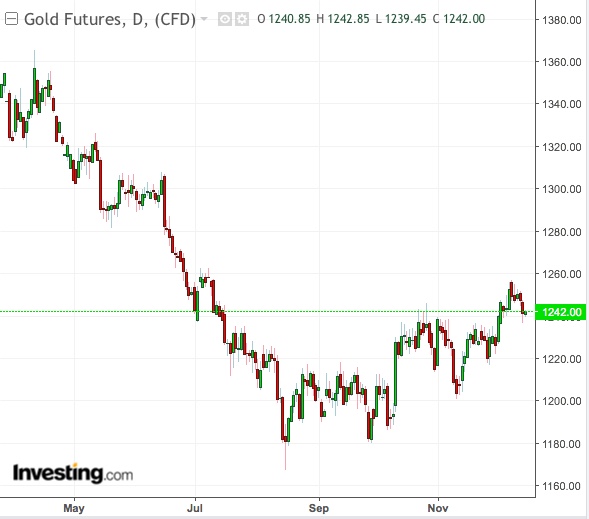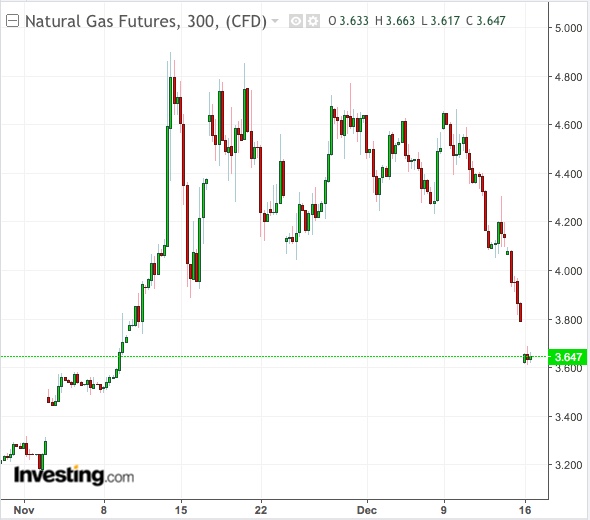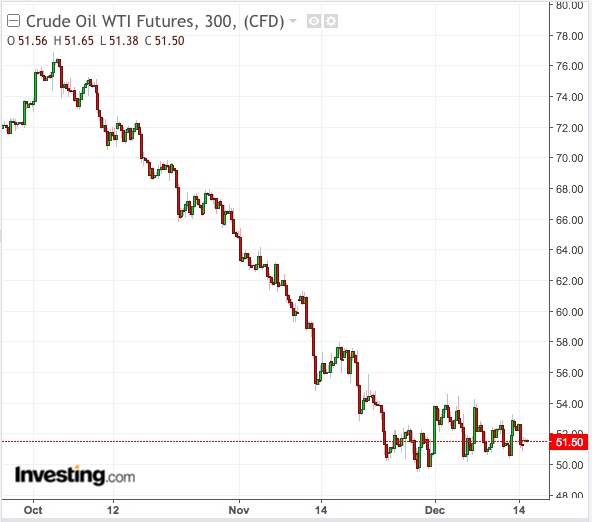OPEC has promised oil output cuts and the Saudis are planning their first strike with shipments to the US. Yet, these factors alone aren’t expected to push crude prices into a sustained rally before year end, with traders likely to wait out 2019 demand data before taking any action. Fears of a global slowdown and skepticism over US-China ties could also cap activity in oil.
The story could be a little different for gold, which faces a pivotal week with the Federal Reserve scheduled to decide on whether it should hike rates for a fourth time this year. The market has priced in a 75.8 percent chance of a 2.00-2.25% rate increase at the conclusion of the central bank’s December 18-19 policy meeting.

With many betting the Fed will pause any tightening cycle after December, the dollar is expected to gain modestly if there’s indeed a hike on Wednesday. But if the central bank stays the course, it could be a precursor to sharp weakness in the greenback in early 2019, a factor that may drive gold toward April’s $1,300 high over the next two weeks.
Gold Could Be Seen As 'Savior' If Fed Stalls On Rate Hike
Chuck Butler, managing director of EverBank Global Markets and a Fed watcher of more than 35 years, indicated that a stalled rate hike at this juncture could add to worries of a potential recession. In an interview published on the NASDAQ site on Friday, Butler said: “Things will eventually get (to look) so bad, that gold will be the savior.”
Other than the Fed decision, investors in gold are also expected to pay particular attention to US housing data for November on Tuesday and final Q3 economic growth on Friday, along with Brexit negotiations, where Britain’s embattled Prime Minister Theresa May has less than four months to act on her divorce plans for the UK from the EU.
More Near-Term Pressure Expected In Natural Gas

Among other closely-watched commodities, natural gas will be scrutinized for how much more it could lose before the year is out, after this month’s shocking drop of 21 percent thus far, following November’s equally staggering surge of 41 percent. Just over a month ago, natural gas was up 60 percent on the year.The sheer volatility has forced the fuel to concede its number one spot for commodities performance to wheat, which is now up 24 percent on the year. (desktop users, click here and go to “performance” to see all commodity returns for 2018).
Dan Myers of Gelber & Associates, an energy markets advisory in Houston, Texas, said gas prices have been pummeled by weaker demand for pre-winter heating lately. In a note issued on Friday, he added:
“Milder weather will hamper demand next week and put into question the strength of withdrawals in late-December.”
Crude prices, meanwhile, briefly bucked their lower trend last week, rising as much as 3% in Thursday’s session on a Bloomberg report that Saudi Arabia plans to slash exports to the United States in the coming weeks, in an effort to dampen visible build-ups in crude inventories. Saudi crude shipments to the US next month could even test the 30-year low of 582,000 barrels a day set in late 2017, down about 40 percent from the most recent three-month average, the report said.

Within 24 hours, crude prices gave back all of that rally. With just over two weeks to the end of 2018, US West Texas Intermediate crude remains down about 15% on the year and some 32% lower from its four-year highs of nearly $77 per barrel hit in early October. UK-traded Brent, the global benchmark for oil, is down about 10% on the year and nearly 32% lower from four-year highs of nearly $87 per barrel, hit two months ago.
US-Focused Saudi Oil Cuts Not An Immediate Game-Changer
Dominick Chirichella of the Energy Management Institute in New York said although Saudi Arabia’s US-focused cuts on crude supply were as bullish a factor to oil as any, they weren’t an immediate game-changer due to worries about a global economic slowdown in 2019, along with anxiety that the US-China trade truce may only consist of symbolic victories rather than any actual progress.
In a note issued at the weekend, Chirichella acknowledged the Saudi production cuts reported by Bloomberg “could be the beginning of a new uptrend”. He, however, added:
“I am not ready to jump into the bullish waters right now. I am maintaining my overall oil view and short-term bias at neutral as we see how the new OPEC accord plays out in the early stages.”
